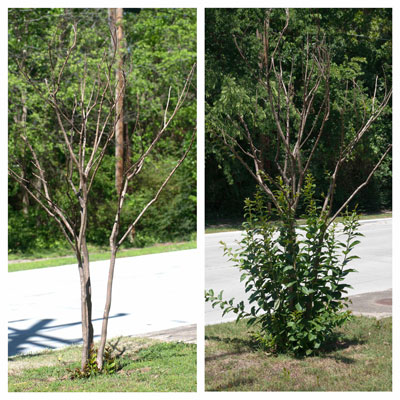Crape Myrtle Cut-back
In the city that’s been designated as America’s Crape Myrtle City by the U.S. Congress, McKinney features more than 20,000 crape myrtle plants in pretty much all the known varieties.
That makes McKinney a pretty good testing ground for things like season of bloom, mature height, fall color – and winter hardiness.
Two facts to remember:
• Crape myrtles are a sub-tropical plant. In their native homes they’re not subjected to really cold winters.
• McKinney is north of Dallas, and winters can be rather cold in McKinney. (Respect paid to Amarillo and North Dakota. We still get cold by crape myrtle standards.)
Therefore, we do occasionally see freeze damage to some of the less hardy varieties. Types like Natchez, Tuscarora, Muskogee and the old variety Country Red commonly freeze to the ground. Such was frequently the case this year.

Photo: April 4 on left, May 15 on right. Note how strongly the plant has regrown.
I took the photo on the left on April 4 in McKinney. I posted it on Facebook along with the suggestion that the homeowner really needed to trim out the dead wood quickly so the new shoots could start filling in.
I was back on that same street this Monday, and I noticed that the plant is growing strong, but that the dead stems are still there. My first thought was to show you how rapidly the plant had regrown, but then I realized how difficult it will now be to remove the dead stalks without doing damage to the brittle new shoots.
Game plan here should still be to remove the dead stems carefully. Leave all of the new shoots in place until fall. At that point, select the 7 or 8 straightest stems and leave them. Remove the rest. Next year, perhaps in early summer, the new growth will be sturdy enough to allow the gardener to remove all of the extra stalks and start training the three or five (odd numbers look most natural) that remain.
It’s pretty amazing how quickly crape myrtles regrow. That’s why we also recommend retraining plants that have been butchered (as in “topped”) by cutting them completely to the ground in the winter, then waiting for the regrowth to pop up come spring. Do that one time, and promise your plants that they’ll never be topped again and you can have lovely crape myrtles within 18 months.
